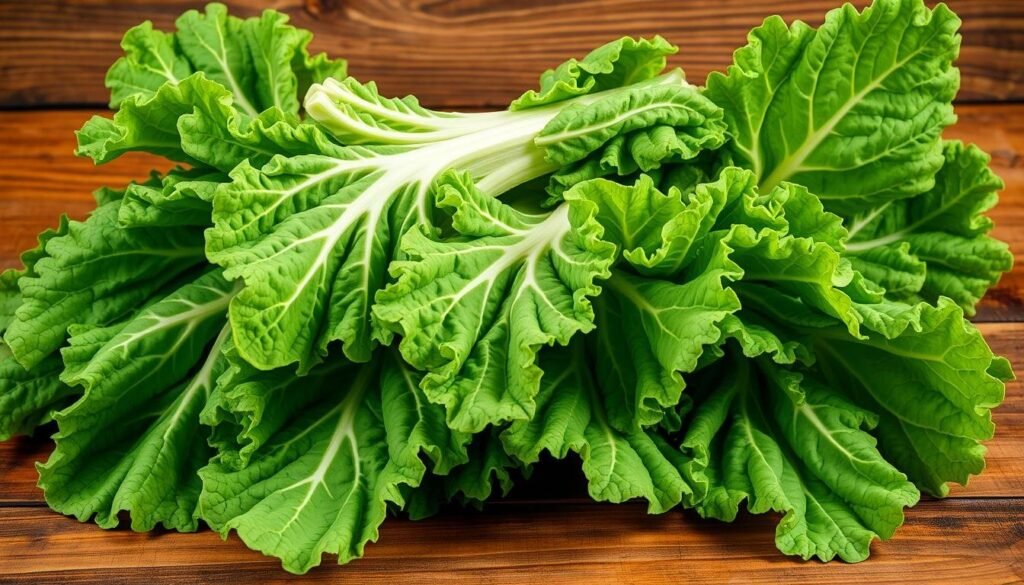Can You Eat Cauliflower Leaves? Cauliflower is a versatile vegetable known for its nutritious florets. Yet, many of us overlook the potential of its leaves. These leaves are rich in nutrients and offer several health benefits. They make a great addition to various meals.
Exploring the edibility of cauliflower leaves shows their potential in cooking. They can enhance the nutritional value of your meals and add flavor and texture. Learning how to add these leaves to your diet can boost your nutrient intake.
As we explore cauliflower leaves, you’ll discover their benefits and how to use them in cooking. This will help you make the most of this often-overlooked vegetable part.
Contents
- 1 Understanding Cauliflower Leaves
- 2 Can You Eat the Leaves of Cauliflower?
- 3 Nutritional Value of Cauliflower Leaves
- 4 Preparing Cauliflower Leaves for Cooking
- 5 Cooking Methods for Cauliflower Leaves
- 6 Delicious Recipes Using Cauliflower Leaves
- 7 Considerations When Eating Cauliflower Leaves
- 8 Conclusion: Can You Eat Cauliflower Leaves?
- 9 FAQ
- 9.1 Are cauliflower leaves safe to eat?
- 9.2 How do I clean cauliflower leaves?
- 9.3 Can I eat cauliflower leaves raw?
- 9.4 What are the nutritional benefits of cauliflower leaves?
- 9.5 How can I store cauliflower leaves?
- 9.6 Can I freeze cauliflower leaves?
- 9.7 Are there any potential allergens or interactions associated with eating cauliflower leaves?
Understanding Cauliflower Leaves
Cauliflower leaves are a hidden gem in the world of vegetables. They offer a unique taste and texture. When you explore the cauliflower plant, you’ll find that the leaves are not only edible but also packed with nutrients.
The appearance of cauliflower leaves can vary. They are typically green, sometimes with a purplish tint. The size of the leaves can also vary, depending on the cauliflower variety.
The taste of cauliflower leaves is often described as slightly bitter and earthy. It’s similar to other leafy greens like kale or collard greens. You can use them in soups, salads, or as a sautéed side dish. Different types of cauliflower, such as white, purple, or Romanesco, may have leaves with slightly different characteristics. But they are generally interchangeable in recipes.
Understanding the basics of cauliflower leaves is essential for incorporating them into your cooking. They can add variety to your meals and provide a boost of nutrients. By learning more about cauliflower leaves, you can make the most of this often-overlooked vegetable.
Can You Eat the Leaves of Cauliflower?
Are you curious if you can eat cauliflower leaves? The answer is yes. They are not only safe but also nutritious for your meals.
Cauliflower leaves taste a bit bitter, like kale or collard greens. They can be used in many dishes. This makes them a great addition to your cooking.
Safety Considerations
Before eating cauliflower leaves, make sure they are fresh and clean. Here are some tips:
- Check for signs of spoilage, such as wilting or discoloration.
- Make sure the leaves are free of pesticides or other chemicals.
- Wash the leaves thoroughly before cooking or eating.
Look for crisp, green leaves to ensure they are fresh. Avoid wilted or yellowed leaves. Adding cauliflower leaves to your diet can be healthy and fun.
Nutritional Value of Cauliflower Leaves
Cauliflower leaves are packed with nutrients, offering a wealth of health benefits. They can be a great addition to your meals. These leaves are rich in vitamins and minerals, making them a healthy choice.
They are a good source of vitamins C and K, and also have a lot of vitamin A. Cauliflower leaves are also full of potassium and manganese. These minerals help keep your blood pressure healthy and support your bones. Plus, they have antioxidants that protect your cells from harm.
Eating cauliflower leaves can boost your immune system and reduce inflammation. The antioxidants and nutrients in these leaves improve your overall health.
You can use cauliflower leaves in many ways. Try sautéing, steaming, or adding them to soups and stews. Using the whole cauliflower plant is a sustainable way to cook and reduces waste.
Preparing Cauliflower Leaves for Cooking
To get cauliflower leaves ready for cooking, start by cleaning them. Rinse them under cold water to get rid of dirt or debris.
Next, trim the leaves to remove tough stems and any damaged parts. Cut the leaves into smaller pieces. This makes them easier to cook and use in your recipes.
Keep the cleaned and trimmed leaves fresh by storing them in an airtight container. Place them in the fridge. They can stay fresh for up to a day.
| Step | Action | Purpose |
|---|---|---|
| 1 | Rinse under cold water | Clean the leaves |
| 2 | Trim tough stems | Make leaves ready for cooking |
| 3 | Store in airtight container | Preserve freshness |
When preparing cauliflower leaves, handle them gently. This helps keep their texture and nutritional value. By following these steps, you can enjoy your cauliflower leaves in many dishes.
Cooking Methods for Cauliflower Leaves
Cauliflower leaves can be cooked in several ways. You can steam, sauté, or boil them. Each method brings out a unique flavor and texture.
Steaming, Sautéing, and Boiling
Steaming is a great way to keep the nutrients in cauliflower leaves. Just place the leaves in a steamer basket over boiling water. Cover and steam for 3-5 minutes until they’re tender.
Sautéing is another quick method that enhances the flavor. Heat some olive oil in a pan. Add minced garlic if you like, then add the leaves. Cook until they’re wilted, usually in 2-3 minutes.
Boiling is simple but needs careful timing to avoid overcooking. Submerge the leaves in boiling water for 2-3 minutes. Then, drain them immediately.
| Cooking Method | Cooking Time | Notes |
|---|---|---|
| Steaming | 3-5 minutes | Preserves nutrients, tender result |
| Sautéing | 2-3 minutes | Quick, flavorful, can add garlic |
| Boiling | 2-3 minutes | Simple, but beware of overcooking |
Choosing the right cooking method makes cauliflower leaves a tasty and healthy addition to your meals. Try different techniques to find your favorite way to prepare them.
Delicious Recipes Using Cauliflower Leaves
You can unlock the full potential of cauliflower by using its leaves in your recipes. This not only reduces food waste but also adds nutrition and flavor to your meals.
Cauliflower leaves are great in many dishes, from soups to salads, and stir-fries to sautés. Here are a few ideas to get you started:
- Cauliflower Leaf Soup: Blend cooked cauliflower leaves with your favorite broth and cream for a creamy soup.
- Cauliflower Leaf Salad: Toss chopped cauliflower leaves with mixed greens, cherry tomatoes, and a tangy vinaigrette.
- Stir-Fried Cauliflower Leaves: Stir-fry cauliflower leaves with garlic, ginger, and your choice of protein for a quick and easy dinner.
| Recipe | Main Ingredients | Preparation Time |
|---|---|---|
| Cauliflower Leaf Soup | Cauliflower leaves, broth, cream | 20 minutes |
| Cauliflower Leaf Salad | Cauliflower leaves, mixed greens, cherry tomatoes | 15 minutes |
| Stir-Fried Cauliflower Leaves | Cauliflower leaves, garlic, ginger, protein | 10 minutes |
When using cauliflower leaves in recipes, choose fresh, tender leaves for the best flavor and texture. You can also mix cauliflower leaves with other ingredients to create delicious and nutritious meals.

By adding cauliflower leaves to your cooking, you can make your meals more varied and nutritious. You can also reduce food waste. Try out different recipes and enjoy the benefits of this often-overlooked ingredient.
Considerations When Eating Cauliflower Leaves
Cauliflower leaves are not only edible but also packed with nutrients. However, it’s crucial to be cautious. Some people might have allergic reactions to them. Symptoms can include itching, swelling, or stomach problems.
It’s also important to watch out for interactions with medications. The high vitamin K in cauliflower leaves can affect blood clotting. If you’re taking blood thinners, talk to your doctor before adding cauliflower leaves to your diet.
To stay safe, make sure to clean and cook the leaves well. This step can lower the risk of getting sick from food. By being careful, you can enjoy the nutritional benefits of cauliflower leaves, like their vitamins and minerals.
Always get your cauliflower leaves from trusted sources or grow them yourself. This way, you avoid pesticides and other harmful substances.
Conclusion: Can You Eat Cauliflower Leaves?
Now that you’ve learned about cauliflower leaves, it’s time to get creative. You can eat them and they’re full of vitamins and antioxidants. This makes them a great addition to your meals.
Cauliflower leaves can be cooked in many ways. You can sauté, steam, or add them to soups and stews. Try different methods to find your favorite way to enjoy them.
Using cauliflower leaves in your cooking helps reduce waste and adds nutrition to your meals. Next time you’re cooking with cauliflower, don’t forget to use the leaves. They offer many benefits.
See Also: Can You Eat Dead Crabs That Have Been on Ice?
FAQ
Are cauliflower leaves safe to eat?
Yes, cauliflower leaves are safe to eat. They can add nutrition to your meals. Just clean and prepare them properly first.
How do I clean cauliflower leaves?
Rinse cauliflower leaves under cold water. Gently scrub off dirt or debris. Soaking them in cold water can also help loosen dirt.
Can I eat cauliflower leaves raw?
You can eat cauliflower leaves raw, but they taste better cooked. Cooking makes them tender and easier to eat.
What are the nutritional benefits of cauliflower leaves?
Cauliflower leaves are packed with vitamins A, C, and K. They also have minerals like calcium and iron. Plus, they’re full of antioxidants and anti-inflammatory compounds.
How can I store cauliflower leaves?
Wrap cauliflower leaves in a damp paper towel. Then, put them in a sealed container or plastic bag. Store them in the fridge to keep them fresh for a few days.
Can I freeze cauliflower leaves?
Yes, you can freeze cauliflower leaves. Blanch them in boiling water for 30 seconds. Then, shock them in an ice bath. Frozen leaves are great in soups and stews.
Are there any potential allergens or interactions associated with eating cauliflower leaves?
Eating cauliflower leaves can cause allergic reactions or intolerance. People with thyroid problems should be careful with cruciferous veggies like cauliflower.

Hello, I am Bellamy George, a certified nutritionist and food safety specialist from Springfield, IL. With a degree in Food Science, I share research-backed insights on edible foods, seeds, and seafood for safe, informed eating.

